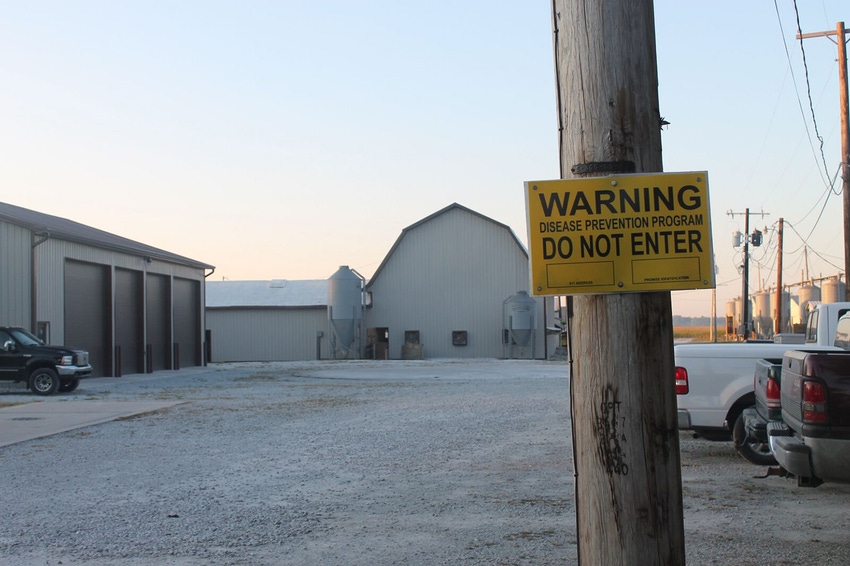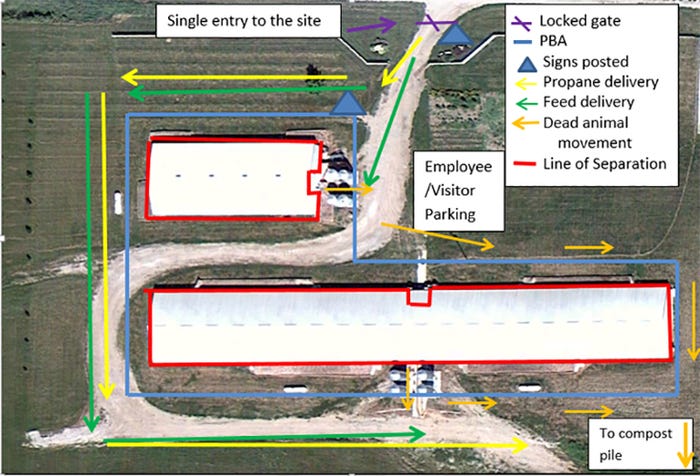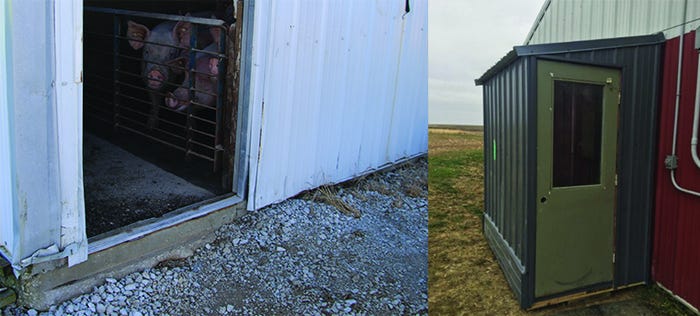Two biosecurity concepts in the SPS plan are the perimeter buffer area and the line of separation, which make up two layers of protection around a farm.
October 1, 2019

By Kristin Olsen and Amanda Chipman, Iowa Pork Industry Center; Pam Zaabel and Danelle Bickett-Weddle, Center for Food Security and Public Health, Iowa State University
It’s been over a year since African swine fever was discovered in China, and discussions of ASF and foreign animal disease threat to the U.S. have since been continuous. One way you can prepare is through the Secure Pork Supply plan. The SPS plan is designed to help pork producers maintain business continuity during an outbreak of a foreign animal disease (ASF, classical swine fever or foot and mouth disease), by helping you prepare the items necessary to request a movement permit if your farm is located in a regulatory control area.
If you are unfamiliar with Secure Pork Supply, these short videos provide a brief introduction. The three main components of the SPS plan are traceability, biosecurity and disease monitoring. This article will focus on the biosecurity aspects of the plan.
When the United Kingdom faced an outbreak of FMD, farmers with good biosecurity procedures were five times less likely to become infected.1 Ensuring that farms have proper biosecurity measures in place before allowing pigs to move will be critical in preventing the spread of an FAD. But implementing enhanced biosecurity is not just about checking the boxes to set yourself up for requesting a movement permit in an outbreak. Going a few steps beyond your routine biosecurity could help protect your pig herd from becoming infected, and could be the difference between waiting several days to move pigs, and euthanizing your entire site after an FAD infection.
Two biosecurity concepts in the SPS plan are the perimeter buffer area and the line of separation, which make up two layers of protection around a farm. The LOS is the layer closest to the pigs (most often the walls of a building). The PBA serves as a second layer of protection. Adding this buffer area, with controlled access points and biosecurity measures to cross, helps decrease the chance of virus getting near the pigs. A vehicle crossing the PBA needs to be cleaned and disinfected. A person crossing the PBA will put on clean footwear or booties, and gloves or hand-sanitizer. This adds one additional layer of protection around the animals by minimizing cross traffic of on-farm people and vehicles with potentially contaminated off-farm traffic.
There are many ways to implement a PBA on a farm; the blue line on the map below shows one example of how a PBA could work on this site. The PBA does not necessarily have to be the physical perimeter of the site; it should be drawn however it can best be implemented. For example, it may not be practical for your site to clean and disinfect a truck every time feed is delivered. You may consider drawing your PBA near the feed bins in a way that the truck and driver would not need to cross the PBA to deliver feed.

The line of separation is the last layer protecting your animals from disease. Many farms already have an LOS and controlled LOS access points in place (for example, a clean/dirty line or shower). People and equipment crossing the LOS need to follow biosecurity measures.
Change into site-specific footwear.
Cover street clothes completely with site-specific coveralls, or change into farm clothes.
Wash hands/hand sanitizer, gloves.
Equipment, personal items (like lunches, cell phones) should be disinfected.
When it comes to marking your PBA and LOS, the important thing is that you, your employees and anyone coming onto your farm understands where there are barriers to entry, where they are allowed to go and where they are not allowed to go, and how to properly cross the PBA/LOS at access points. We have seen many creative ways to mark a PBA. Some are expensive (a tall, chain link fence), but some are very inexpensive (cement poured in five gallon buckets with a post and a rope strung between).
The same goes for marking your LOS. A bench system is a great option for an LOS access point. There are some farms where a bench is not an option. For example, a farm where personnel entry and animal entry/load-out must go through the same door. Even a red line spray painted on the floor clearly marking the LOS is much more biosecure than no line. Another challenge is a finisher with no office or space separating the door from the pig area. One example of a solution to this problem is adding a small “entry-way” to the door of the building to create space between the entry and the pig area. Communication and training with employees and visitors are also key for making an effective PBA and LOS.

Every farm, even those with the most advanced biosecurity practices, can make small improvements to reduce disease risk. Completing an SPS plan and implementing enhanced biosecurity now, before an outbreak occurs, will help you be ready if an outbreak in the U.S. ever does happen. Just remember that we are working to protect our pigs, our businesses and our industry from devastating disease. Producers can make a difference in keeping our industry safe.
Ready to start with your farm’s SPS plan? The Secure Pork Supply site is a great place to begin. Need assistance? Consider contacting us at the Iowa Pork Industry Center. We’re committed to helping the industry prepare for an outbreak by helping individual producers complete their SPS plans.
1Unpublished research: Carlisle Epidemiology Team, DEFRA, UK 2001 Outbreak
Source: Kristin Olsen and Amanda Chipman, Iowa Pork Industry Center; Pam Zaabel and Danelle Bickett-Weddle, Iowa State University, which is solely responsible for the information provided, and wholly owns the information. Informa Business Media and all its subsidiaries are not responsible for any of the content contained in this information asset.
You May Also Like



